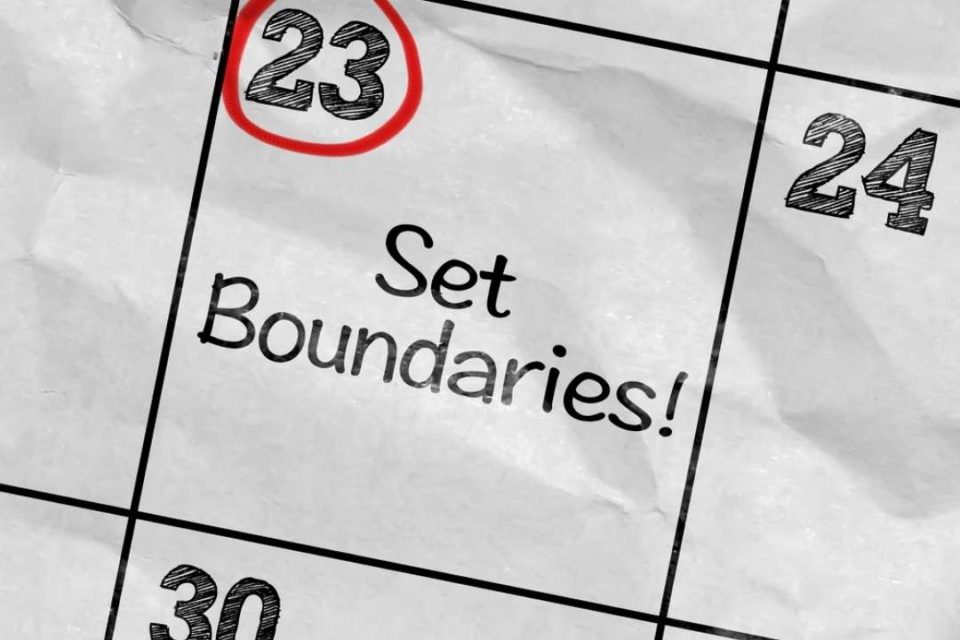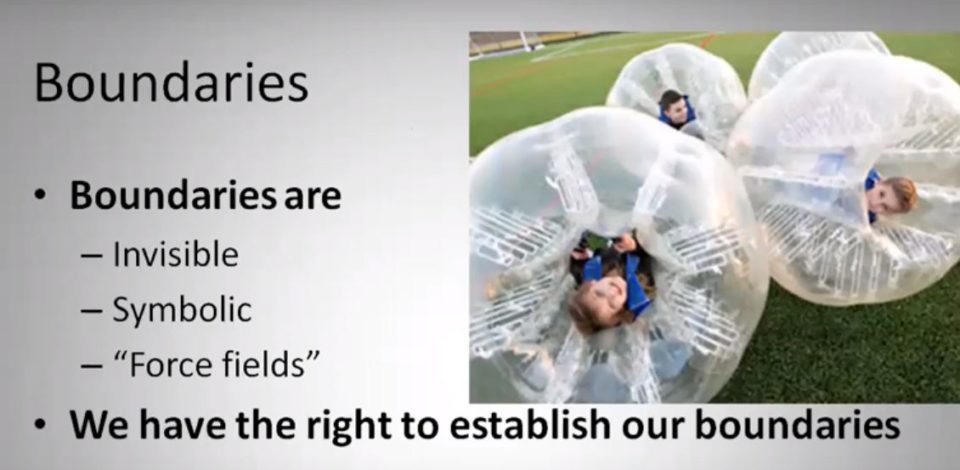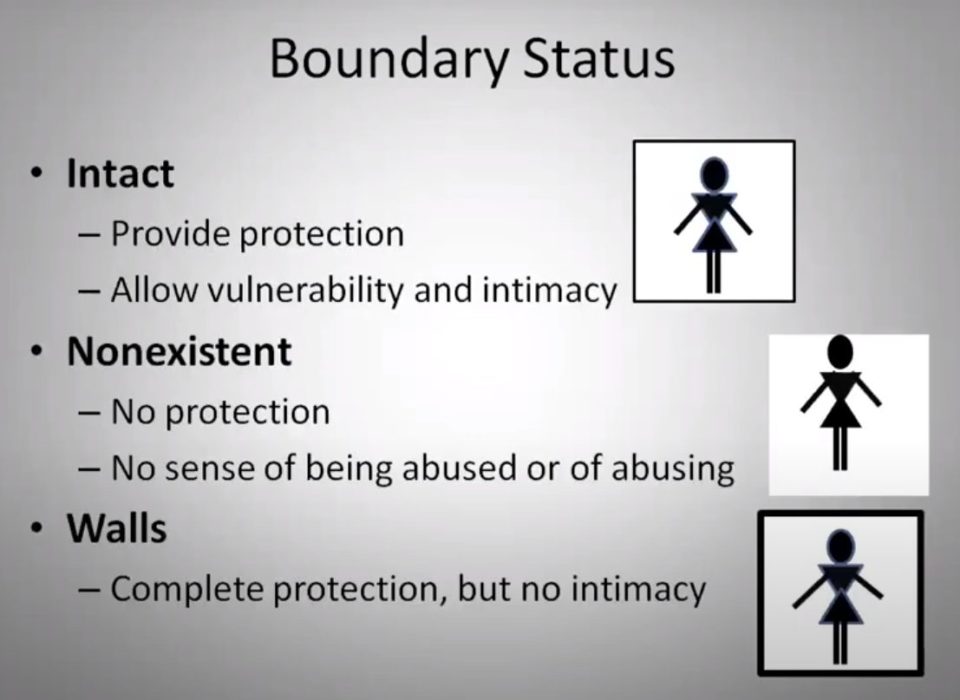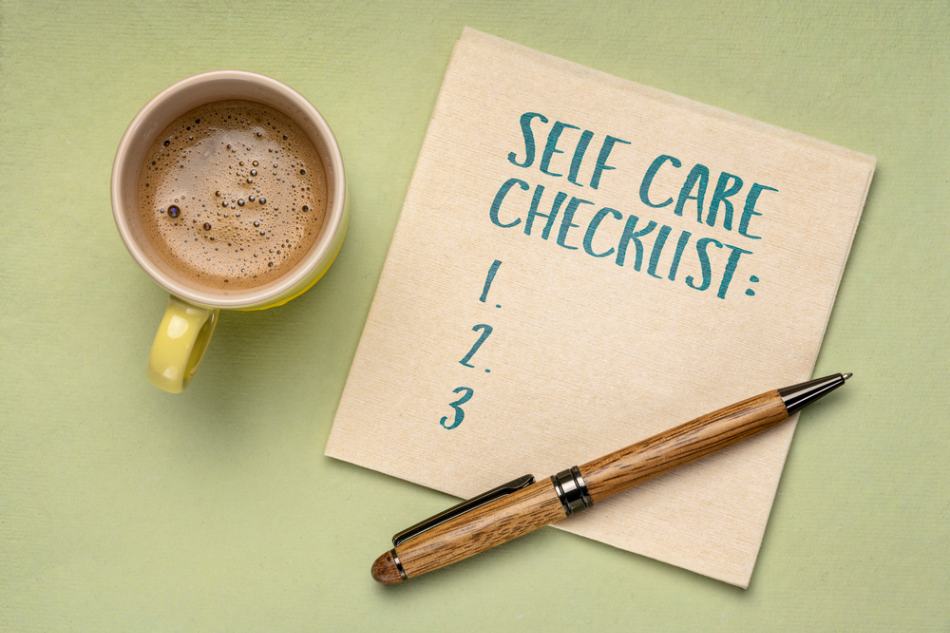July 9, 2020
Webinar: Establishing Healthy Boundaries in Relationships
Written by Rachel Eddins
Posted in Relationships, Couples, Marriage, Webinars and with tags: Relationships, boundaries

With healthy boundaries, you can begin to understand that you have rights and that you can set limits in your relationships.
- Do you find that people tend to run over you?
- Do they insist on doing things their way, leaving you with the feeling that you have no choice but to go along?
- Or do they intrude into your life in ways that are uncomfortable for you?
Learn what healthy boundaries are and how to build them.
Learn how to gently, but firmly let people know that they are “stepping on your toes” and that you want them to stop.
Building healthy boundaries takes practice, but it is worth the effort as you begin to ask for what you need and to have those needs respected.
Facilitated by Joan Mullinax.
Watch a replay of the presentation here.
Learn more about our relationship counseling services.
Here is a transcription of the webinar:
Hello, my name is Joan Mullinax and I’m with Eddins Counseling Group. I focus on personal growth and development and career development, so I spend a lot of time working with people to develop healthier boundaries. What we’re going to be talking about is healthy boundaries in relationships.
What are Boundaries?

I found this lovely picture and it is as close as I could come to a visual description of boundaries.
What are boundaries?
Boundaries are invisible. They’re symbolic and they are “forcefield”. One of the things I want to say upfront that’s extremely important and that I will probably reiterate throughout the presentation is that we have a right to establish our boundaries.
We’re going to talk a whole lot more about how to do that so if you can imagine these kids, you could translate them into your nearest grocery store during covid and the bubbles being invisible and watching the human beings kind of do this, dance around and try to stay six feet away from each other mostly. That’s one of the places where we’re seeing boundaries very actively exercised and in some cases violated these days.
I’m going to provide you with some information about boundaries:
- what they are
- what purpose do they serve
- unhealthy and healthy boundaries,
- examples in which you have struggled to have healthy boundaries in a relationship.
I am also going to give you a two-hour framework that you can use to have healthy conversations about setting boundaries that are healthy both for others and for yourself.
Boundaries in Physical Space
Let’s just test our experience with boundaries. Have you ever had an experience where there was somebody who stood too close to you? Or somebody who touched your property without your permission?
I can think about an engineer that I worked with years and years ago, and I always felt uncomfortable around him and I couldn’t figure out for the longest time why. And then I realized he was always just a little too close to me for my comfort. Being a software engineer at the time, I didn’t have any real tools to talk about boundaries and say: “Can you step back, please?”
If you have that sense of somebody being too close to you or somebody touching your personal property that you don’t even give information to, that means your boundaries are being violated.
And you can often feel it. Some people feel it like energy, like two magnets that you’ve got the same pole going toward each other where they’re pushing against each other. If anybody’s ever studied any Chinese martial arts, tai chi, chi gong, it’s like feeling the energy potentially between your hands and things like that.
Not everybody is going to experience it as a sensation, but you’re going to at least experience it if you have boundaries as a push, a violation, or a discomfort.
What is the Purpose of Boundaries?
According to Pia Melody, the purpose of boundaries are to:
- Protect self
- From other’s “Hoo Hah”
- Protect others
- From our “Hoo Hah”
- Define me/not me
Let’s talk about the purpose of boundaries. If you’re going to talk about boundaries these days, one of the key people that you’re going to refer to is Pia Melody. I had the pleasure of sitting in on a presentation that Pia Melody did in Houston several years ago. She gave us some very technical terminology to talk about the purposes of boundaries.
What she told us was that they were to protect ourselves from other people’s Hoo Hah and to protect others from our Hoo Hah. I’ll let you fill in the blank as to what she might mean by Hoo Hah, but I found that very helpful.
They also are useful for defining what’s me and what’s not me. Not all of us have a real clear picture of where we end and where someone else begins.
If you watch a young child discovering their body and they grab a hold of their toes, they have this real sense of: “Oh, that’s me!”, and they didn’t know it until they grabbed their toes, so we’re going to be talking more about that.
Types of Boundaries
- External
-
- Physical
- Sexual
- Internal
Let’s start by talking about types of boundaries. You can go into this subject in a much greater depth than I’m going into today. I’m going to try to give you some fundamental concepts and I’m going to give you a practical exercise that you can begin to use in your own life. If you’re a therapist, you can begin to use it with your clients. This is an exercise that Pia Melody created called the talking boundary.
The types of boundaries that we have are external and internal. And the external boundaries are physical boundaries and sexual boundaries. Then we’ll go a little bit deeper talking about each of those.
External Boundaries
-
Physical:
-
How close someone is allowed to get to you
-
Whether they can touch your personal property
-
This varies dramatically depending on who the person is and the circumstances that you’re in. You probably have encountered some people at certain times in your life, like the girlfriend who borrowed your sweater and bringing it brought it home smelling like alcohol and tobacco. That was a boundary violation. She had permission to wear the sweater, but not to bring it back on that.
-
Sexual
- Sexual distance
- Sexual touch
- With whom
- Where
- How
Sexual boundaries have to do with sexual distance, sexual touch, with whom you will be sexual, where you will be sexual, and how you will be sexual.
When you think about with whom has this person gained my trust or am I taking risks here? Is this someone that I deeply trust and they are welcome to approach me sexually and frequently, they also welcome my approach sexually?
The where can be anywhere from your bedroom with the doors closed and the kids in the other room, it can be your bedroom on date night with the kids are at your parent’s house (the door doesn’t have to be closed and you don’t have to worry if you’re getting a little too frisky when you’re being sexual).
The other thing is how are you being sexual? Take a glance at the Kama Sutra and you’ll get a sense of how many different ways there are to be sexual and you will be comfortable with some of them and not comfortable with others. It’s very important that you recognize where you’re comfortable, where you are distinctly uncomfortable and where you might be willing to experiment. Those are all things that could come up in dealing with external sexual boundaries.
Internal Boundaries
Protect our
- Behavior
- Feelings
- Thinking
From others
Internal boundaries are a little trickier. I’m going to talk about them more later when we get more specific about the example. It’s to protect our behavior, feeling, and thinking from others. So this means others not controlling our behavior, others not trying to tell us that we don’t have the feelings, that we have others attacking our thoughts.
Protect others from our:
- Behavior – tone of voice, e.g.
- Feelings
- Thinking
It’s also to protect others from our behavior. For example, tone of voice or word choice. It also is to protect others from our feelings. So when we start talking about the talking boundary, one of the things we’re going to talk about is how one talks to another person about one’s feelings when they’re having what may be a challenging conversation.
Also, it protects others from her thinking. If you try to talk politics right now, this is a good place for setting boundaries because they’re not civil conversations happening between people with opposing points of view.
Boundary Status
The boundary status can be in a variety of states and the state that your boundaries in can vary dramatically depending on who you’re around.
Can be
- Intact
- Nonexistent
- Damaged
- Walls
- Vacillating
I’ll go into more detail on this so your boundaries can be intact. These are the healthiest boundaries that you can have because it gives you the most flexibility. They can be non-existent. You don’t even know what they mean.
When somebody first introduced me to the concept of boundaries, I must have had the blankest look on my face because my mother considered the boundaries in my family of origin, as going from wall to wall, with no boundaries between the other six people who are occupying the household. And she saw no problem at all with that. It took me a long time to figure out that that was a problem.
Boundaries can also be damaged.
We can have walls instead of boundaries, and then you can also vacillate from walls to nonexistent.

Boundaries Provide Protection
Here are some pictures, and if we have any gentlemen, I apologize for the fact that we only have ladies, I was using a drawing tool that I was having challenges with. Rather than try to work with gender, I decided to get all my pictures in.
Intact boundaries provide protection and allow for vulnerability and intimacy. So in this picture, you can see right now this person has her boundaries. If she were with somebody that she was very close to, she might let these boundaries in and let them get closer to her.
Nonexistent boundaries means no protection.
The next person has nonexistent boundaries, so they have no protection from other people’s abuses or even opinions. Sometimes they have no sense of being abused or of abusing.
They don’t realize that their actions are potentially abusive to others because they have nonexistent boundaries. Moms learning to have children are great examples of experiments with transitions from nonexistent boundaries to intact boundaries.
Walls provide complete protection, but they provide no intimacy.
So you’ll notice we got a much thicker surface here. Now, one of the things that Pia Melody talks about is the external boundary and she talks about it as an external shell or a bell jar that keeps things away from you.
What is the source of your boundaries?
- Taught by primary caregivers
-
Beliefs – rights to boundaries, e.g.
-
Feelings – which are welcome, which are not
-
Behavior – what is allowed, not allowed
Now we’re pushing where the boundaries come from and I’ve already dropped some hints about this. They are taught by our primary caregivers and this is plural because you might have one parent who has a reasonable sense of boundaries and another who has no sense of boundaries at all.
You may have one parent that has walls, you may have one parent who is inconsistent. Sometimes they’re available, sometimes they’re not available. So you’re taught about things like beliefs.
Do you have the right to have boundaries?
Do you have the right to say, this is my body, you can touch it or not touch it, you can touch it this way or not touch it?
People with siblings get lots of opportunities to practice their boundaries because siblings are really great at pushing the limits on those things.
Feelings, what which feelings are welcome, which are not welcome.
We learn to silence the ones that are not welcome and be more expressive with the ones that are.
Behavior, what is allowed and what’s not allowed.
There’s a healthy aspect of this in the sense of protecting you before you know how to protect yourself. Also, protecting others from you, like protecting your siblings from you when you get mad.
There are also instances in which behavior that you’re taught is not allowed. When you become an adult you may discover that there are behaviors that are allowed that were blocked for you before.
You may have been gracefully taught that these are private and not evil, which makes it a little bit easier whenever you start to emerge as a sexual being.
Using the Talking Boundary
Purpose – to discuss an issue with someone
Mindset
- I am standing solidly on my own two feet, neither leaning toward the person or away
- I have the right to my experience
- I am responsible for my own thoughts, feeling, and behavior
- Use “I statements”
- “You statements” come across as accusing
Let’s get into the talking boundary. Usually, this is where you’re going to have a conversation with somebody on something that is an issue. So it may not be something that’s easy to talk about.
One of the things I’m going to encourage you to do is as you begin to practice the talking boundary, that you start in low-stakes situations. For example, you can tell your server that your steak is too darn, rather than starting with your intimate partner on some long-standing issue.
The purpose of the talking boundary is to discuss an issue with someone and I think it’s very important to get the mindset associated with the talking boundary.
Normally, if I were in my office, I would be standing up about now and I would be saying:
“I’m standing solidly on my own two feet, I’m neither leaning forward to the other person and being aggressive with them, nor am I leaning away, and being passive. I recognize that I have a right to my experience. My experience is allowed and it is not something that someone else can take away with me. On the other side of that coin, I’m responsible for my own thoughts, feelings, and behavior.”
You know how easy it is when you’re having a difficult conversation, and we say: “You make me so mad. You hurt my feelings or whatever it is, you make me feel like…”. As you develop some sense of healthy boundaries, you begin to go: “That is not about me, that is about them. What I think is what I think and I’m entitled to what I think, and in fact, I own what I think.”
Use I Statements
As we get into this talk about using I statements.
The You statements tend to come across as accusing, so I’m going to point my finger at you and I want you to see how that feels when I point my finger at you.
Usually, it feels pretty uncomfortable, just even in a relatively neutral setting like this, where somebody points their finger at you as if they’re making an accusation.
1. Use Sensory Data to Describe What You Observed
We’re going to start at just the basic framework of the talking boundary, so we’re going to start with sensory data, something you can see, smell, taste, feel or hear.
We also know that we have some other senses that hadn’t been counted previously, so we have our intro section where we can tell you what’s going on inside of our body, and where our body is oriented in space. We also are very deeply social at the cellular level and have a well-defined, defined brain structure for reading human faces.
Sometimes the sensory data may be something that you have to go a little bit beyond the five senses or you can say:
When I see your nose going up like that, I think…
So you are still trying to go over the sensory data there.
We’re going to go for the thought that you’re that the sensory data bring into your mind.
Then we’ll go for the emotions that you feel and that can be triggered by the thoughts that you have.
It can also be colored by your experiences from the past.
Then the last part of the talking boundary is we’re going to make a request for future behavior.
2. Focus on Observable Behavior
Let’s go into this in more detail. On the sensory data, we’re talking about observable behavior, so: Not when you yelled at me, but
When your voice got louder.
It’s like if an outsider were observing this, it would say yes, in fact, the voice got louder.
And it also is a very loaded word. This is where we begin to exercise our internal boundaries by choosing our words very carefully about what we say. So, we might have the inclination to say “When you turned your back on me” and we might even throw a little body language into it. So that’s when our internal boundaries are starting to kind of bump out against the other person.
We might say instead something about “When you turned away from me. When I heard you say: I don’t want to talk right now”. So it’s sensory data.
Example of Sensory Data & Observable Behavior:
I’m going to walk you through a personal example of this with my significant other.
The sensory data:
When you turned away from me when I said something to you.
He turned away as I was saying something to him and nothing more than that. He didn’t turn his back on me, He didn’t stomp out of the room or any of those other lovely loaded phrases that we like to use for sensory data.
3. Identify the Thoughts You Had Using I Statements
Then we’re going to talk about our thoughts.
Sometimes this language feels a little bit artificial when you start out. In fact, sometimes even the people that we start using the talking boundary with us will begin to heckle us about I statements.
So you’ll have to have some tolerance about that. It’s one of the reasons I recommend that you start in low-stakes situations, plus you’ll get your language more fluent as you practice.
So what I made up was which was triggered from my past was:
I assumed you didn’t care about what I had to say.
I assumed that, so I’m owning the fact that I made an assumption.
4. Communicate the Emotions You Felt in Response to Your Thoughts
Then the emotions I felt in response to the thought. So, the person did not make you feel this way.
It’s important to own your own feelings. They often arise from our thoughts and from what we’ve experienced in the past.
So in my example of talking to my significant other, I say:
I felt dismissed and unheard.
Those are my feelings, I’m entitled to those feelings.
He can say: “You shouldn’t have felt that way”, but when we come to the vulnerable request, you’ll see that I haven’t made any assumptions about how he’s treating me from the sensory events that I observe.
5. Make a Vulnerable Request of What You’d Like in the Future
In the future, what I’d prefer is…
I would appreciate it if you would have your hearing checked and consider getting hearing aids.
I happen to know this man has hearing problems and they are untreated, so I’m beginning to recognize when he is not hearing me and when he didn’t want to hear me, those are two different things.
- The other person may accept your request.
- They may decline your request.
- They may make a counteroffer to your request.
If you own your own experience and a person consistently declined your request, that’s really useful information that you want to pay attention to.
Because you have just made a vulnerable about your needs. You have been very responsible about maintaining your internal boundaries and not attacking this person, and yet they’re saying, “No, not going to do that”.
And especially if they’re saying, nope, not going to do that, where it’s kind of, let’s see, what would the outsiders say? Well, it was negative, so they declined your request, and the brief not going to do that sounded a little bit cut.
What if your requests are consistently denied?
Remember, you’re responsible for your thoughts, behaviors, and feelings, you’re responsible for your own well-being and you have choices.
So if you begin to discover that you’re in a relationship with someone who consistently declines your reasonable, vulnerable requests, you may have some choices to make.
For some people that means taking this challenging question into the safe environment of couples therapy.
For some people, couples therapy is not an option, and they can talk to the person who does relationship counseling, but they work primarily with one individual, and that individual then practices in real life.
But if you think of a relationship it has a certain balance and if one person shifts, it’s impossible for the balance in the relational dynamic not to shift.
I will tell you that I have been stunningly surprised as I’ve begun to use this style of communication at the difference between the response I expected to get and the one I actually got. I’m finding that people are much more open to what I have to say and are much more likely to either respond in the affirmative or come up with a counteroffer that we can both agree to.
Boundaries and Communication – Resources
So you’ve had a little time to look at this. Let me tell you about the resources that I drew this from, one was the classic Piam Melody with Andrew Wells and Jaquiss Miller facing codependents, what it is, where it comes from, and how it sabotages our lives. So the little boundary drawings came from that because codependents tend to have had boundary injuries.
Melody Beattie’s book “Beyond Codependency: And Getting Better All the Time” is the subsequent book from her first book, “Beyond Codependency”. Then if you really want to dig deeper into this Get a hold of the intimacy factor, and factor the ground rules for overcoming the obstacles to truth respect, and long-lasting love.
Are you ready to put your toe in the water and begin to try it out in lower-stakes situations? Do you think it’s a bunch of hogwash and you don’t see it as being useful at all?
Questions?
Are there activities that you would specifically use when one party is resistant?
Sometimes you will come up with resistance from the person who is trying to use the talking boundary. And this can be for a variety of reasons. For some of them, they have if they have lived an unbounded life, the ability to begin to establish boundaries can be terrifying to them. So you have to start really slow with them, you may even ask them to practice with you if you worked with them long enough to have a good relationship with them.
You suggest that they start in very safe situations, people that they’re never going to see again if they want to, they can practice on the dog. Dogs are pretty easy and are very they’re not necessarily going to give you the answers that you want, but they will allow you to say out loud what you need to say without your getting any pushback.
So one is working with the person who is trying to develop their ability, their healthy boundaries, and their ability to communicate with someone in a boundary way.
Then on the other side of the coin is say you’re in a couple situations and there’s someone who’s not willing to play.
Sometimes I think that’s a good time to ask the person what their purpose is in being there.
Now, you wouldn’t necessarily want to laugh about it, but in some cases that is a useful question. To ask somebody:
- What brings you into couples counseling?
- What are you hoping to accomplish?
- Why are you here today?
- How can I be of assistance to you today?
- What are your concerns about this approach?
- Is there some request that you would like to make of your partner that would make it easier for you to listen to what they have to say?
Hot to deal with a situation when the partner believes they are never wrong?
“I have a dear friend who has a husband who has a bad temper and believes he’s never wrong, he’s a bit of a bully and I’ve noticed he isn’t open to negotiation. It isn’t an option to stop seeing her. So I’m curious as to how best to deal with the situation.”
Insights on Dealing with Resistance
One is you would hope that your friend would be open to being encouraged to see a therapist on her own. The other thing is to find a safe environment in which to carry on your conversations with your friend. Hopefully, there’s an opportunity to safely have coffee or even sit on the patio if the husband is sufficiently rigid that even the wife’s having a conversation with you is problematic.
Make your conversation nice and visible, but preferably not audible, and give that a try and see if it works. Try this methodology if this were your friend or your spouse, how would you approach them with this methodology?
So the husband has a bad temper, so if an outsider were watching, what would he/she see?
Would he be raising the volume of his voice? Would he be making judgemental statements about his wife? How does his bad temper show up? Is he physically abusive or physically threatening? Is he financially abusive or financially threatening?
If this was a person that you needed to talk to, how would you go about talking to this person? It’s going to have to be very careful because they’re got walls up and it’s going to take time.
There is a wall of anger and walls make people safe but they also keep them from having deep relationships with people.
So if this is a person who wants to have a deep relationship with his wife, he may want to start listening to her if that matters to him. If it doesn’t matter to him, then that’s useful for her.
We hope that she will at least stay in therapy so she can work on her own boundaries, and skills and begin to use them in her relationship and see if he is capable of making more positive responses to that.
Psychoeducation
Book study psychoeducation can be extremely useful. A good resource for couples is a book by Dr. Sue Johnson “Hold Me Tight”. She got into the notion of the reason that people get into these life and death struggles in their intimate relationships is that they’re dealing with attachment issues.
As adults, our primary attachment issue is with our intimate other, and when we experience a breach in the attachment bond, our nervous system experiences it as if it’s a life-threatening experience.
How Do You Apply Boundaries in a Workplace Setting?
Hopefully, you will find that there is leadership that supports setting appropriate boundaries. Sometimes it’s the leadership that needs boundaries set with them and that can be particularly challenging. Sometimes you can find allies above the leader who’s the problem. And sometimes you can’t. And sometimes in jobs, if it turns out that it’s a toxic environment and it’s not going to change, then you may want to look for a healthier environment because I work with a lot of people on getting them out of toxic environments and there are better and worse work environments.
How can I encourage someone to open up and tell me something in the moment rather than later?
“I’ve got a boyfriend, that is a people-pleasing type. He always struggles with setting boundaries with people, so I keep finding out months after the fact that I have encroached upon a boundary and I didn’t even know he had. How can I encourage him to open up and tell me something at the moment rather than later? I feel like every time we discuss it, the conversation doesn’t really go anywhere.”
Work can be done in therapy on this. If your work with him individually, you’re going to want to use every bit of your social skills. Your brain is very good at reading facial expressions and body language. Try to begin to notice when the “NO” happens, but didn’t get verbalized”. You may start to get subtle hints that you can pick up on that you can then ask about at the time.
“It seems to me like you might have preferred to have Italian rather than Chinese tonight.” And, you know, he may say: “No, no, no, it’s fine either way, either way, is fine with me”. But you turn your head to the side as if maybe you weren’t so sure. And I’m wondering whether that was true or you are imagining things.
So it’s paying very close attention, encouraging, and, engaging people to participate in therapy. Read the books that go into more detail on this. Actually, the intimacy factor might be a very useful one in that situation, because you’ve got a relationship that there are some things we’re talking about and that there are some things that aren’t that might be a useful tool to begin working on that.
Contact Us
If you have any questions, reach out. If I don’t have the answer, I have colleagues who will and would be happy to be of service to you in any way that we can.
Grounding & Self Soothing
Get instant access to your free ebook.






















